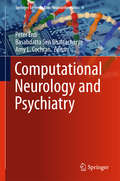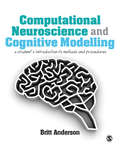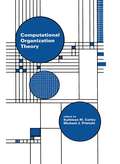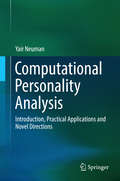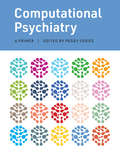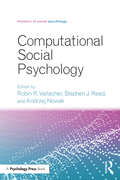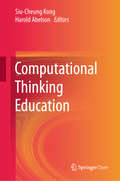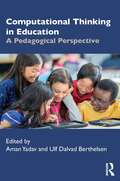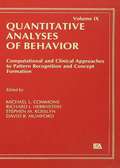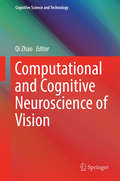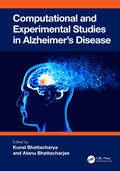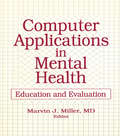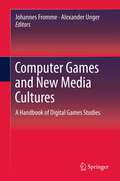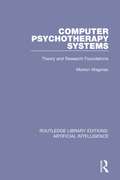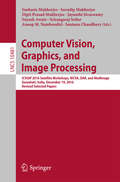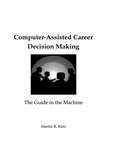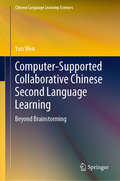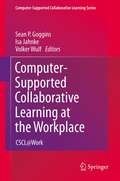- Table View
- List View
Computational Models of Conditioning
by Nestor SchmajukSince first described, multiple properties of classical conditioning have been discovered, establishing the need for mathematical models to help explain the defining features. The mathematical complexity of the models puts our understanding of their workings beyond the ability of our intuitive thinking and makes computer simulations irreplaceable. The complexity of the models frequently results in function redundancy, a natural property of biologically evolved systems that is much desired in technologically designed products. Experts provide the latest advancements in the field and present detailed descriptions of how the models simulate conditioned behaviour and its physiological bases. It offers advanced students and researchers examples of how the models are used to analyse existing experimental results and design future experiments. This volume is of great interest to psychologists and neuroscientists, as well as computer scientists and engineers searching for ideas applicable to the design of robots that mimic animal behaviour.
Computational Neurology and Psychiatry (Springer Series in Bio-/Neuroinformatics #6)
by Péter Érdi Basabdatta Sen Bhattacharya Amy L. CochranThis book presents the latest research in computational methods for modeling and simulating brain disorders. In particular, it shows how mathematical models can be used to study the relationship between a given disorder and the specific brain structure associated with that disorder. It also describes the emerging field of computational psychiatry, including the study of pathological behavior due to impaired functional connectivity, pathophysiological activity, and/or aberrant decision-making. Further, it discusses the data analysis techniques that will be required to analyze the increasing amount of data being generated about the brain. Lastly, the book offers some tips on the application of computational models in the field of quantitative systems pharmacology. Mainly written for computational scientists eager to discover new application fields for their model, this book also benefits neurologists and psychiatrists wanting to learn about new methods.
Computational Neuroscience and Cognitive Modelling: A Student's Introduction to Methods and Procedures
by Britt Anderson"For the neuroscientist or psychologist who cringes at the sight of mathematical formulae and whose eyes glaze over at terms like differential equations, linear algebra, vectors, matrices, Bayes' rule, and Boolean logic, this book just might be the therapy needed." - Anjan Chatterjee, Professor of Neurology, University of Pennsylvania "Anderson provides a gentle introduction to computational aspects of psychological science, managing to respect the reader's intelligence while also being completely unintimidating. Using carefully-selected computational demonstrations, he guides students through a wide array of important approaches and tools, with little in the way of prerequisites...I recommend it with enthusiasm." - Asohan Amarasingham, The City University of New York This unique, self-contained and accessible textbook provides an introduction to computational modelling neuroscience accessible to readers with little or no background in computing or mathematics. Organized into thematic sections, the book spans from modelling integrate and firing neurons to playing the game Rock, Paper, Scissors in ACT-R. This non-technical guide shows how basic knowledge and modern computers can be combined for interesting simulations, progressing from early exercises utilizing spreadsheets, to simple programs in Python. Key Features include: Interleaved chapters that show how traditional computing constructs are simply disguised versions of the spread sheet methods. Mathematical facts and notation needed to understand the modelling methods are presented at their most basic and are interleaved with biographical and historical notes for contex. Numerous worked examples to demonstrate the themes and procedures of cognitive modelling. An excellent text for postgraduate students taking courses in research methods, computational neuroscience, computational modelling, cognitive science and neuroscience. It will be especially valuable to psychology students.
Computational Organization Theory
by Kathleen M. Carley Michael J. PrietulaThis volume represents an advance in our understanding of how to represent and reason about organizational phenomena. Although organizational theorists have long grappled with the complexities of adaptive agents, ecological systems, and non-linear relations among the basic elements of organizational design, they have not, until recently, had the tools to grapple with these complex relationships. Recent advances in logic, symbolic programming, network analysis, and computer technology have made possible a series of tools that can be used to understand the complexities of organizational behavior. New computational techniques make it possible to develop and test more realistic models of organizational behavior. This volume offers examples of this new breed of models, and provides insight into how these advances and techniques can be used to extend our theoretical understanding of organizations. Authored by leading researchers in the area of computational organization theory, the various chapters demonstrate the value of computational analysis for organizational theory and advance our understanding of the relationship between organizational design and performance. This book contains both theoretical and methodological contributions that enable organizational theorists to use computational and mathematical techniques to systematically address the complex relationships that underlie organizational life. It also presents new -- or sometimes, renewed -- approaches on how to conduct organizational research from multiple formal perspectives including: simulation, numerical analysis, symbolic logic, mathematical modeling, and graph theory.
Computational Personality Analysis: Introduction, Practical Applications and Novel Directions (Springerbriefs In Complexity Ser.)
by Yair NeumanThe emergence of intelligent technologies, sophisticated natural language processing methodologies and huge textual repositories, invites a new approach for the challenge of automatically identifying personality dimensions through the analysis of textual data. This short book aims to (1) introduce the challenge of computational personality analysis, (2) present a unique approach to personality analysis and (3) illustrate this approach through case studies and worked-out examples. This Brief is of special relevance to psychologists, especially those interested in the new insights offered by new computational and data-intensive tools, and to computational social scientists interested in human personality and language processing.
Computational Psychiatry: A Primer
by Peggy SerièsThe first introductory textbook in the emerging, fast-developing field of computational psychiatry.Computational psychiatry applies computational modeling and theoretical approaches to psychiatric questions, focusing on building mathematical models of neural or cognitive phenomena relevant to psychiatric diseases. It is a young and rapidly growing field, drawing on concepts from psychiatry, psychology, computer science, neuroscience, electrical and chemical engineering, mathematics, and physics. This book, accessible to nonspecialists, offers the first introductory textbook in computational psychiatry.
Computational Psychiatry: A Systems Biology Approach to the Epigenetics of Mental Disorders
by Rodrick WallaceThis book explores mental disorders from a uniquely evolutionary perspective. Although there have been many attempts to mathematically model neural processes and, to some extent, their dysfunction, there is very little literature that models mental function within a sociocultural, socioeconomic, and environmental context. Addressing this gap in the extant literature, this book explores essential aspects of mental disorders, recognizing the ubiquitous role played by the exaptation of crosstalk between cognitive modules at many different scales and levels of organization, the missing heritability of complex diseases, and cultural epigenetics. Further, it introduces readers to valuable control theory tools that permit the exploration of the environmental induction of neurodevelopmental disorders, as well as the study of the synergism between culture, psychopathology and sleep disorders, offering a distinctively unique resource.
Computational Psychometrics: With Examples in R and Python (Methodology of Educational Measurement and Assessment)
by Robert J. Mislevy Alina A. von Davier Jiangang HaoThis book defines and describes a new discipline, named “computational psychometrics,” from the perspective of new methodologies for handling complex data from digital learning and assessment. The editors and the contributing authors discuss how new technology drastically increases the possibilities for the design and administration of learning and assessment systems, and how doing so significantly increases the variety, velocity, and volume of the resulting data. Then they introduce methods and strategies to address the new challenges, ranging from evidence identification and data modeling to the assessment and prediction of learners’ performance in complex settings, as in collaborative tasks, game/simulation-based tasks, and multimodal learning and assessment tasks.Computational psychometrics has thus been defined as a blend of theory-based psychometrics and data-driven approaches from machine learning, artificial intelligence, and data science. All these together provide a better methodological framework for analysing complex data from digital learning and assessments. The term “computational” has been widely adopted by many other areas, as with computational statistics, computational linguistics, and computational economics. In those contexts, “computational” has a meaning similar to the one proposed in this book: a data-driven and algorithm-focused perspective on foundations and theoretical approaches established previously, now extended and, when necessary, reconceived. This interdisciplinarity is already a proven success in many disciplines, from personalized medicine that uses computational statistics to personalized learning that uses, well, computational psychometrics. We expect that this volume will be of interest not just within but beyond the psychometric community.In this volume, experts in psychometrics, machine learning, artificial intelligence, data science and natural language processing illustrate their work, showing how the interdisciplinary expertise of each researcher blends into a coherent methodological framework to deal with complex data from complex virtual interfaces. In the chapters focusing on methodologies, the authors use real data examples to demonstrate how to implement the new methods in practice. The corresponding programming codes in R and Python have been included as snippets in the book and are also available in fuller form in the GitHub code repository that accompanies the book.
Computational Social Psychology (Frontiers of Social Psychology)
by Robin R. Vallacher; Stephen J. Read; Andrzej NowakComputational Social Psychology showcases a new approach to social psychology that enables theorists and researchers to specify social psychological processes in terms of formal rules that can be implemented and tested using the power of high speed computing technology and sophisticated software. This approach allows for previously infeasible investigations of the multi-dimensional nature of human experience as it unfolds in accordance with different temporal patterns on different timescales. In effect, the computational approach represents a rediscovery of the themes and ambitions that launched the field over a century ago. The book brings together social psychologists with varying topical interests who are taking the lead in this redirection of the field. Many present formal models that are implemented in computer simulations to test basic assumptions and investigate the emergence of higher-order properties; others develop models to fit the real-time evolution of people’s inner states, overt behavior, and social interactions. Collectively, the contributions illustrate how the methods and tools of the computational approach can investigate, and transform, the diverse landscape of social psychology.
Computational Thinking Education
by Siu-Cheung Kong Harold AbelsonThis This book is open access under a CC BY 4.0 license.This book offers a comprehensive guide, covering every important aspect of computational thinking education. It provides an in-depth discussion of computational thinking, including the notion of perceiving computational thinking practices as ways of mapping models from the abstraction of data and process structures to natural phenomena. Further, it explores how computational thinking education is implemented in different regions, and how computational thinking is being integrated into subject learning in K-12 education. In closing, it discusses computational thinking from the perspective of STEM education, the use of video games to teach computational thinking, and how computational thinking is helping to transform the quality of the workforce in the textile and apparel industry.
Computational Thinking in Education: A Pedagogical Perspective
by Aman YadavComputational Thinking in Education explores the relevance of computational thinking in primary and secondary education. As today’s school-aged students prepare to live and work in a thoroughly digitized world, computer science is providing a wealth of new learning concepts and opportunities across domains. This book offers a comprehensive overview of computational thinking, its history, implications for equity and inclusion, analyses of competencies in practice, and integration into learning, instruction, and assessment through scaffolded teacher education. Computer science education faculty and pre- and in-service educators will find a fresh pedagogical approach to computational thinking in primary and secondary classrooms.
Computational and Clinical Approaches to Pattern Recognition and Concept Formation: Quantitative Analyses of Behavior, Volume IX (Quantitative Analyses of Behavior Series)
by Stephen M. Kosslyn Richard J. Herrnstein Michael L. Commons David B. MumfordThe ninth volume in this highly acclaimed series discusses the computational and clinical approaches to pattern recognition and concept formation regarding: visual and spatial processing models; computational models, templates and hierarchical models. An ideal reference for students and professionals in experimental psychology and behavioral analysis.
Computational and Cognitive Neuroscience of Vision (Cognitive Science and Technology)
by Qi ZhaoDespite a plethora of scientific literature devoted to vision research and the trend toward integrative research, the borders between disciplines remain a practical difficulty. To address this problem, this book provides a systematic and comprehensive overview of vision from various perspectives, ranging from neuroscience to cognition, and from computational principles to engineering developments. It is written by leading international researchers in the field, with an emphasis on linking multiple disciplines and the impact such synergy can lead to in terms of both scientific breakthroughs and technology innovations. It is aimed at active researchers and interested scientists and engineers in related fields.
Computational and Experimental Studies in Alzheimer's Disease
by Atanu Bhattacharjee Kunal BhattacharyaThis reference book compiles the recent advances in computational and experimental modelling to screen and manage Alzheimer’s disease. It covers basic etiopathology and various in vitro and in vivo strategies of disease intervention. The book discusses how computer-aided drug design approaches reduce costs and increase biological test efficiency. It reviews the screening for anti-Alzheimer drugs and biomarker analysis of disease inhibitors. The book also explores mechanistic aspects of neurodegeneration and the use of natural products as therapeutics for Alzheimer’s disease.Key features: Elaborates on the computational modelling of protein target inhibitors as anti-Alzheimer’s agents Explains the role of phytomolecules and natural products in Alzheimer’s therapy Reviews preclinical ways to assess drugs focusing on Alzheimer’s disease Covers biomarker analysis for Alzheimer’s disease Discusses the onset and progression of Alzheimer’s disease The book is meant for professionals, researchers, and students of neuroscience, psychology, and computational neurosciences.
Computational, Geometric, and Process Perspectives on Facial Cognition: Contexts and Challenges (Scientific Psychology Series)
by Michael J.Wenger James T.TownsendWithin the last three decades, interest in the psychological experience of human faces has drawn together cognitive science researchers from diverse backgrounds. Computer scientists talk to neural scientists who draw on the work of mathematicians who explicitly influence those conducting behavioral experiments. The chapters in this volume illustrate the breadth of the research on facial perception and memory, with the emphasis being on mathematical and computational approaches. In pulling together these chapters, the editors sought to do much more than illustrate breadth. They endeavored as well to illustrate the synergies and tensions that inevitably result from adopting a broad view, one consistent with the emerging discipline of cognitive science.
Computer Application in Fire Protection Engineering
by Paul R. DeCiccoA collection of papers that address such issues as model limits and reliability, emerging expert systems and integrated gas and solid phase combustion simulation models.
Computer Applications in Mental Health: Education and Evaluation
by Marvin MillerThis practical book describes computer programs designed specifically for mental health clinicians and their work. It examines a variety of computer resources and some of the latest developments in the field. Computer Applications in Mental Health provides examples of computer programs that have proved helpful in private practice and institutional treatment settings. Among the programs discussed in the book are those that have succeeded or failed within the large Veterans Administration computer system; a system designed to help choose the best reinforcers to use with patients in a behavioral program; a computerized self-administered screening battery in use in community health center settings; patient education programs useful in caring for the chronic mentally ill; and a reminder system for helping the hospital-based clinician meet paperwork deadlines. Encouraging mental health professionals to investigate the types of computer technology available to them, this book also stimulates further development and sharing of computer software.To enable readers to seek out more information on certain systems and programs, this book lists many computer resources. Several of the software packages evaluated are available on computerized bulletin board systems at no cost beyond that of a long distance phone call. Although Computer Applications in Mental Health is primarily for mental health clinicians, administrators and computer programmers within mental health settings can also find useful information in this book.
Computer Games and New Media Cultures: A Handbook of Digital Games Studies
by Alexander Unger Johannes FrommeDigital gaming is today a significant economic phenomenon as well as being an intrinsic part of a convergent media culture in postmodern societies. Its ubiquity, as well as the sheer volume of hours young people spend gaming, should make it ripe for urgent academic enquiry, yet the subject was a research backwater until the turn of the millennium. Even today, as tens of millions of young people spend their waking hours manipulating avatars and gaming characters on computer screens, the subject is still treated with scepticism in some academic circles. This handbook aims to reflect the relevance and value of studying digital games, now the subject of a growing number of studies, surveys, conferences and publications. As an overview of the current state of research into digital gaming, the 42 papers included in this handbook focus on the social and cultural relevance of gaming. In doing so, they provide an alternative perspective to one-dimensional studies of gaming, whose agendas do not include cultural factors. The contributions, which range from theoretical approaches to empirical studies, cover various topics including analyses of games themselves, the player-game interaction, and the social context of gaming. In addition, the educational aspects of games and gaming are treated in a discrete section. With material on non-commercial gaming trends such as 'modding', and a multinational group of authors from eleven nations, the handbook is a vital publication demonstrating that new media cultures are far more complex and diverse than commonly assumed in a debate dominated by concerns over violent content.
Computer Psychotherapy Systems: Theory and Research Foundations (Routledge Library Editions: Artificial Intelligence #10)
by Morton WagmanOriginally published in 1988, this was the first book to examine the development, application and evaluation of computer counselling and psychotherapy. Integrating concepts of artificial intelligence and psychotherapy, this book provided extensive research data that compared the human therapist to the computer therapist at the time. This title was intended for researchers, professionals, and students of psychotherapy and artificial intelligence. By exploring the automation of therapy and the design of empathetic software this book challenges counsellors and computer scientists to look at what may have been the most fascinating topic to arise in their fields for years to come.
Computer Supported Collaborative Learning 2005: The Next 10 Years!
by Timothy Koschmann Daniel D. Suthers Tak-Wai ChanThe Computer Supported Collaborative Learning (CSCL) conference has become an internationally-recognized forum for the exchange of research findings related to learning in the context of collaborative activity and the exploration of how such learning might be augmented through technology. This text is the proceedings from CSCL 2005 held in Taipei, Taiwan. This conference marked the 10th anniversary of the first CSCL Conference held at Indiana University in 1995. Subsequent meetings have been held at the University of Toronto, Stanford University, University of Maastricht (Netherlands), University of Colorado at Boulder, and the University of Bergen (Norway).Just as the first CSCL conference was instrumental in shaping the trajectory of the field in its first decade, the conference in Taipei will play an important role in consolidating an increasingly international and interdisciplinary community and defining the direction of the field for the next 10 years. This volume, and the papers from which it is comprised, will be an important resource for those active in this area of research and for others interested in fostering learning in settings of collaboration.
Computer Vision, Graphics, and Image Processing: ICVGIP 2016 Satellite Workshops, WCVA, DAR, and MedImage, Guwahati, India, December 19, 2016 Revised Selected Papers (Lecture Notes in Computer Science #10481)
by Snehasis Mukherjee Suvadip Mukherjee Dipti Prasad Mukherjee Jayanthi Sivaswamy Suyash Awate Srirangaraj Setlur Anoop M. Namboodiri Santanu ChaudhuryThis volume contains the proceedings of the third international conference on Pattern Recognition and Machine Intelligence (PReMI 2009) which was held at the Indian Institute of Technology, New Delhi, India, during December 16-20, 2009. This was the third conference in the series. The first two conferences were held in December at the Indian Statistical Institute, Kolkata in 2005 and 2007. PReMI has become a premier conference in India presenting state-of-art research findings in the areas of machine intelligence and pattern recognition. The conference is also successful in encouraging academic and industrial interaction, and in prom- ing collaborative research and developmental activities in pattern recognition, - chine intelligence and other allied fields, involving scientists, engineers, professionals, researchers and students from India and abroad. The conference is scheduled to be held every alternate year making it an ideal platform for sharing views and expe- ences in these fields in a regular manner. The focus of PReMI 2009 was soft-computing, machine learning, pattern recognition and their applications to diverse fields. As part of PReMI 2009 we had two special workshops. One workshop focused on text mining. The other workshop show-cased industrial and developmental projects in the relevant areas. Premi 2009 attracted 221 submissions from different countries across the world.
Computer-Assisted Career Decision Making: The Guide in the Machine
by Martin R. KatzDiscussing career decision making (CDM), career guidance, a computerized system of career guidance, and the interplay among them, this book describes the way people sort themselves, or are sorted, into educational and occupational options. The options represent the content of this book, and the sorting represents the process. The sequence of decisions may extend over a lifetime, but several crucial choice-points tend to occur at predictable stages in a career. Career guidance is a professional intervention in CDM; "professional" implies that practitioners conform to a standard of ethics, knowledge, and competence beyond what may be offered by other intervenors. Guidance is partly an art, but it is also partly a science -- at least an application of science, based on a synthesis of logic and evidence derived from research. The computerized System of Interactive Guidance and Information (SIGI) is a designated guidance "treatment," clearly defined and specified. It was developed according to an explicit model, derived from a particular rationale for guidance, using modern technology to amplify the practice of career guidance. The current version -- called SIGI PLUS TM -- is being used at more than a thousand colleges and universities, as well as secondary schools, libraries, corporations, community-based organizations, and counseling agencies. These three interdependent topics are treated in a progression: from a theory of CDM to a rationale and a model for guidance to the design and development of a system. This book weaves together theory (principles, propositions, rationales, and models), research and development. The product of that development, SIGI, helps to define theory, to exemplify it, and to test it.
Computer-Supported Collaborative Chinese Second Language Learning: Beyond Brainstorming (Chinese Language Learning Sciences)
by Yun WenThis book explores the implementation of an online representational tool, GroupScribbles, in Chinese-as-a-second-language classrooms from primary school to secondary school. It demonstrates the effectiveness of combining online representational tools with face-to-face classroom learning, and provides a workable approach to analysing interactions interweaving social and cognitive dimensions, which take place in the networked classroom. A series of suggestions regarding networked second language learning will help educators effectively implement information and communication technology tools in the classroom.
Computer-Supported Collaborative Learning at the Workplace: CSCL@Work (Computer-Supported Collaborative Learning Series #14)
by Volker Wulf Isa Jahnke Sean P. GogginsThis book is an edited volume of case studies exploring the uptake and use of computer supported collaborative learning in work settings. This book fills a significant gap in the literature. A number of existing works provide empirical research on collaborative work practices (Lave & Wenger, 1987; Davenport, 2005), the sharing of information at work (Brown & Duguid, 2000), and the development of communities of practice in workplace settings (Wenger, 1998). Others examine the munificent variation of information and communication technology use in the work place, including studies of informal social networks, formal information distribution and other socio-technical combinations found in work settings (Gibson & Cohen, 2003). Another significant thread of prior work is focused on computer supported collaborative learning, much of it investigating the application of computer support for learning in the context of traditional educational institutions, like public schools, private schools, colleges and tutoring organizations. Exciting new theories of how knowledge is constructed by groups (Stahl, 2006), how teachers contribute to collaborative learning (reference to another book in the series) and the application of socio-technical scripts for learning is explicated in book length works on CSCL. Book length empirical work on CSCW is widespread, and CSCL book length works are beginning to emerge with greater frequency. We distinguish CSCL at Work from prior books written under the aegis of training and development, or human resources more broadly. The book aims to fill a void between existing works in CSCW and CSCL, and will open with a chapter characterizing the emerging application of collaborative learning theories and practices to workplace learning. CSCL and CSCW research each make distinct and important contributions to the construction of collaborative workplace learning.
Computerized Adaptive and Multistage Testing with R: Using Packages catR and mstR (Use R!)
by Duanli Yan David Magis Alina A. von DavierThe goal of this guide and manual is to provide a practical and brief overview of the theory on computerized adaptive testing (CAT) and multistage testing (MST) and to illustrate the methodologies and applications using R open source language and several data examples. Implementation relies on the R packages catR and mstR that have been already or are being developed by the first author (with the team) and that include some of the newest research algorithms on the topic. The book covers many topics along with the R-code: the basics of R, theoretical overview of CAT and MST, CAT designs, CAT assembly methodologies, CAT simulations, catR package, CAT applications, MST designs, IRT-based MST methodologies, tree-based MST methodologies, mstR package, and MST applications. CAT has been used in many large-scale assessments over recent decades, and MST has become very popular in recent years. R open source language also has become one of the most useful tools for applications in almost all fields, including business and education. Though very useful and popular, R is a difficult language to learn, with a steep learning curve. Given the obvious need for but with the complex implementation of CAT and MST, it is very difficult for users to simulate or implement CAT and MST. Until this manual, there has been no book for users to design and use CAT and MST easily and without expense; i. e. , by using the free R software. All examples and illustrations are generated using predefined scripts in R language, available for free download from the book's website.

